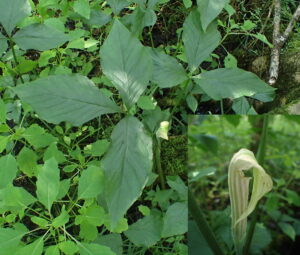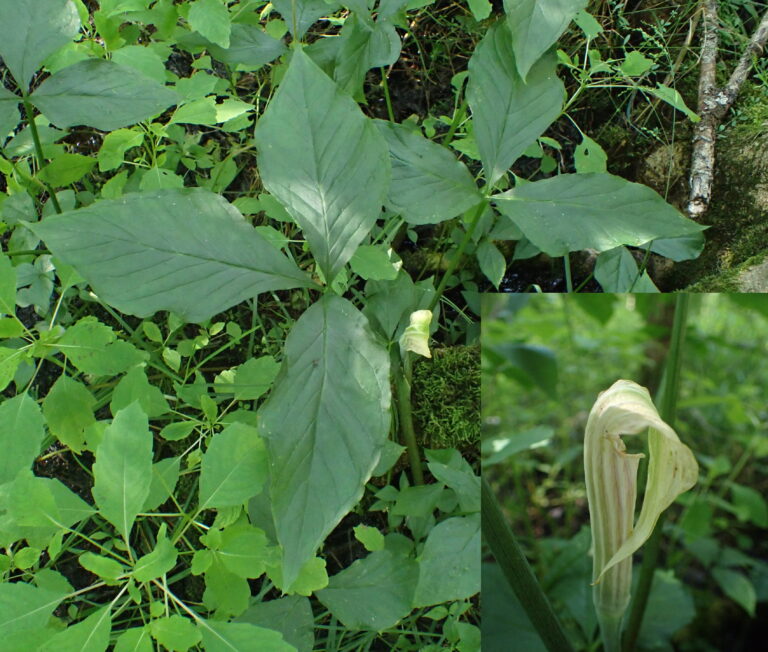
Multiple taxa have been described within the Arisaema triphyllum (L.) Schott complex on the basis of morphological, cytological, and some ecological differences (Treiber 1980; Wyatt and Stoneburner 2022). At least two of these, A. stewardsonii Britton and A. pusillum Nash, are present in eastern Canada but not previously confirmed to occur in Ontario (NatureServe 2024; NHIC 2023; Scoggan 1978). These taxa are not always accepted because the distinguishing morphological characters overlap and are often not discernible in herbarium specimens (e.g., Thompson 2000). Intermediates and hybrids have also been reported (e.g., Huttleston 1949), although Wyatt and Stoneburner (2022) consider there to be little to no evidence of hybridization. Weakley and the Southeastern Flora Team (2023) consider the taxa to behave as biological species, noting that occasional mixed populations show little introgression or hybridization. The NHIC (2023) treats them at the subspecific level and reports only A. t. subsp. triphyllum for Ontario; however, they note that A. t. subsp. stewardsonii (Britton) Huttl. and A. t. subsp. pusillum (Peck) Huttl. are known from southern Quebec and could also be present. There are some iNaturalist records from Ontario initially identified as A. triphyllum that are possibly A. stewardsonii Britton; however, it is not always possible to produce a confident determination when the observer did not deliberately photograph the diagnostic characters. This note serves to confirm the presence of Arisaema stewardsonii within Ontario with a specimen record.
Arisaema stewardsonii is distinguished from other taxa in the complex by its strongly fluted spathe (meaning the spathe has folds with marginal ridges), cylindrical spadix, and green abaxial leaflet surfaces (Wyatt and Stoneburner 2022; Weakley and Southeastern Flora Team 2023). In the common and widespread A. triphyllum s.s., the spathe is not fluted / ridged, the spadix is clavate (club-shaped), and the abaxial leaflet surfaces are glaucous. Arisaema pusillum, reported from southern Quebec, also has a cylindrical spadix and green abaxial leaflet surfaces; however, its spathe is not or only weakly fluted, and the spathe hood is not striped (vs. white stripes in A. stewardsonii).
Arisaema stewardsonii tends to be more restricted to wet sites than is A. triphyllum. Habitat is described as “wet or swampy woods and thickets” (Fernald 1950, for northeastern North America), “rich low woods, mucky areas usually in thickets or along the edges of intervales” (Roland and Smith 1969, for Nova Scotia), bogs and peaty swamps (Wyatt & Stoneburner 2022, for the whole range; Weakley and the Southeastern Flora Team 2023, for southeastern USA). The Ontario specimen record (Chapman-Lam 5820; see Materials for more collection details) is from a Black Ash (Fraxinus nigra) swamp with deep organic muck and no peat moss. We have also seen several individuals within Rideau River Provincial Park (photographs only, see iNaturalist observation 168127783), where it was growing in rich, very moist floodplain swamps. Although these habitats are widespread in Ontario and more work will be required to confirm provincial distribution and abundance, A. stewardsonii may be a provincially rare species. Despite having been reported west to Minnesota (Fernald 1950; GBIF 2024; Wyatt and Stoneburner 2022), the well-curated Arisaema triphyllum (s.l.) records in iNaturalist (GBIF 2024; n = 45,281) show a strong eastern distribution and do not map A. stewardsonii occurrences west of eastern Ohio and the Appalachian Mountains, suggesting that it may be rare and/or inaccurately reported westward. A restricted southeastern Ontario range, in combination with its similarity to A. triphyllum, would account for the absence of previous Ontario records. It is considered of conservation concern in neighbouring Quebec, where its provincial status rank is S3 (Vulnerable; see Master et al. 2012 for rank definitions).
The new, confirmed records were produced during life science inventories for Ontario Parks. We thank Erica Barkley and Jennifer Hoare (Zone Ecologists) for their help during the investigations.
Fernald, M.L. 1950. Gray’s Manual of Botany. American Book Company, New York. 1632 pp.
GBIF. 2024. Arisaema triphyllum (s.l.) records for North America, including A. triphyllum, A. stewardsonii, A. acuminatum, A. pusillum, A. macrospathum and A. quinatum. GBIF Occurrence Download https://doi.org/10.15468/dl.hptw92. Accessed February 15, 2024.
Huttleston, D.G. 1949. The three subspecies of Arisaema triphyllum. Bulletin of the Torrey Botanical Club 76: 407-413.
Master, L., D. Faber-Langendoen, R. Bittman, G.A Hammerson, B. Heidel, L. Ramsay, K. Snow, A. Teucher, and A. Tomaino. 2012. NatureServe Conservation Status Assessments: Factors for Evaluating Species and Ecosystem Risk. NatureServe, Arlington, VA.
NatureServe. 2024. NatureServe Network Biodiversity Location Data accessed through NatureServe Explorer [web application]. NatureServe, Arlington, Virginia. Available https://explorer.natureserve.org/. (Accessed: January 9, 2024).
NHIC. 2023. Ontario Species Lists. Ministry of Northern Development, Mines, Natural Resources and Forestry, Natural Heritage Information Centre. Edition published 19 September 2023, accessed October 2023.
Roland, A.E., and E.C. Smith. 1969. The Flora of Nova Scotia. Nova Scotia Museum, Halifax, NS. 743 pp.
Scoggan, H.J. 1978. The Flora of Canada, Part 2: Pteridophyta, Gymnospermae, Monocotyledoneae. National Museum of Natural Sciences, National Museums of Canada, Ottawa, Canada. https://doi.org/10.5962/bhl.title.122890
Thompson, S.A. 2000. Arisaema. Pp. 139−141, in Flora of North America Editorial Committee (eds.), Flora of North America. Volume 22. Magnoliophyta: Alismatidae, Arecidae, Commelinidae (in part), and Zingiberidae. Oxford University Press, New York.
Treiber, M. 1980. Biosystematics of the Arisaema triphyllum complex. Ph.D. dissertation, University of North Carolina-Chapel Hill, Department of Botany.
Weakley, A.S., and Southeastern Flora Team. 2023. Flora of the southeastern United States. University of North Carolina Herbarium, North Carolina Botanical Garden, Chapel Hill, U.S.A.
Wyatt, R., and A. Stoneburner. 2022. A review of Arisaema (Araceae) in North America: nine species instead of two? Aroideana 45(2): 553-583. PDF available.

Figure. Arisaema stewardsonii habit, with inset showing spathe detail.